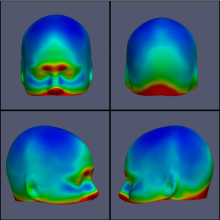Combining 3D morphometry with linear anthropometry to improve the design of specialised headgear
Designers of headgear often still have to rely on outdated anthropometric tables which offer only univariate measurements and very limited information about the variability of the human head. Promising solutions exist to supplement these tables with more complete 3D data, and several 3D model databases are currently on the market. However, these models are often again in the form of univariate tables, from which the designer still needs to interpret the data himself, or in the form of rigid 3D models to be imported in CAD software, which offer no information on variability and no parameterization. This might be sufficient for the design of most current headwear such as hats or earphones, yet emerging specialised headwear will require more accuracy in the placement of several components. One of such emerging applications is Brain-Computer Interfacing (BCI), which enables people to control a computer using headgear that measures their brainwaves. Current BCI headsets have several usability-related issues, such as long set-up times, high complexity and user discomfort, which are caused by a suboptimal fit on the human head. These problems can be solved by taking a new anthropometric approach to the human head.
The goal of this research is to generate a better understanding of the human head by creating a new 3D model that can be used to improve the design process of specialised headgear. The model is created by first using state-of-the-art shape modelling techniques to find the model parameters that best represent the shape and variation of the head, i.e. the principal components. Next, we’ll need to define which anthropometric parameters are currently used for specialized headgear and collect these measurements from the same set of scans. We will then find the correlation between these anthropometric parameters and the model parameters and find a way to make them usable for designers. In order to achieve this, we’ll do an in-depth analysis of the user-centred design process and of the way it is currently implemented in industry. We’ll then create a software plugin for a commonly used CAD software package, which will allow a designer to import our 3D model and parameterise it according to easy to understand anthropometric measurements. The plugin will take care of the translation between these measurements and the principal components and present the user with an optimal 3D head shape, corresponding to the parameters of interest. Of course, this will be verified and the overall effect on the design process will be quantified.
Lastly, a new BCI headset design will be proposed, which will offer maximal usability and user comfort combined with functionality conforming to current headsets. We will achieve this design by taking into account the requirements of all stakeholders, finding the optimal dimensional specifications according to our new anthropometric 3D model and examining the correlation between electrode pressure and user discomfort. The design will be verified by prototyping and testing for fitting and user comfort on a sufficiently large number of healthy test subjects. With further modifications and research, this design will greatly improve the usability and user acceptance of BCI headsets.


